Thar there be bears
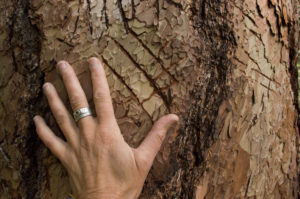

Winter wrens are the tiniest little forest birds yet they have a huge, crazy-long song. They throw their heads back and put their whole body, heart, and soul into each note. They barely weigh a third of an ounce (~9g) but their song resonates throughout the deep forest.
I doubt any human has as much heart or soul as a winter wren, but being about 7,000 times heavier, I hope to make that up through sheer mass.
I want to sing like a winter wren.
A few weeks ago in a random historic-site parking lot in far-flung western Colorado I met a 60-something woman from Atlanta. “You’re traveling alone? Well good for you. I always wanted to do that but I just don’t have the courage. Some day I will. You’ve never had any problems?”
This is a common question when people see me alone. A few variables in wording, some more direct language about scary people and places to avoid, but the sentiment is the same.
I’ve worked alone in many remote places over the years. I have occasionally stepped out of sight when I felt unsure about what was coming my way. I’m more often worried about destroying an axle, not finding my way out of a random maze of canyons, or falling off a cliff than about other people.
A few years ago while traveling in Scotland with an old friend, we were ready to stop for the night; we needed food, Scotch whisky, and a place to stay. We found a pub with a few rooms for let on the second floor but they were already full for the night.
Explaining that we would like to have dinner and a wee dram or two of whisky, we asked for a recommendation on a B&B within walking distance. Oh, well, sit, eat, we’ll call around and see what we can find.
We sat, we drank, we ate.
“So, I found a place for you to stay,” the owner, a rather burly Scotsman, told us. “At ten o’clock I’ll take you out back to the walking bridge over the river. You can take your bags across with you; a man will meet you on the other side with his car, and take you to his B&B for the night.”
My friend and I looked at each other. In the US, this is a set up for an Alfred Hitchcock movie.
He continued, “There’s only one problem.”
We looked at each other again, clearly thinking the same thing: there’s only one problem with a man transferring two American women across a Scottish river to another unknown man in the middle of the night?
“The breakfast is vegetarian.”
Of course, we should have thought of that. A vegetarian breakfast could be a problem; those tempeh sausages just don’t set well with many.
Bad things can happen to men and women. Sometimes they happen in remote places, sometimes not, occasionally to people traveling alone, sometimes not. Obviously, some places are inherently more dangerous, more restrictive, or more stressful. Being open to situations as they unfold and using common sense go a long way toward staying safe.
Every culture, every country, has its idea of what is safe and what is acceptable for women to do. Pushing the envelope with vegetarian sausage is not exactly ground breaking. But being able to travel freely, especially in your own country and specifically in one that prides itself on individual freedom, must not be a privilege.
I am not completely foolhardy. I carry bear spray, not mace but real bear spray, as in, for grizzly bears. I keep it in the truck and take it into the tent/camper with me each night.
Last summer while camping alone in Oklahoma I had the sudden thought that I should check the new canister. It was already late and dark and I was cozy in my tent but had some odd feeling that made me want to be sure it was good to go. Apparently, it was more than good to go. Before I fully removed the glow-in-the-dark safety clip the canister discharged, just a small blast, in the tent.
The tent is pretty roomy for one person – it is, after all, a 2-3-person tent. But no tent of any size is sufficient to escape bear spray. I closed my eyes and gulped spray-free air as soon as I heard the spray escape. Unzipping the tent and staggering outside I could feel the pepper burning into my nose and eyes. Cursing, and laughing at my own stupidity (once again!), with my eyes still shut I wandered the 50 meters to the truck, found the spare key, unlocked the door, found the water containers, and tipping my head sideways, poured two gallons of water across my face.
Eventually I was able to breath freely again and my eyes stopped burning and watering but the tent took much longer to air (think: weeks) and every time I turned in my sleeping bag a little puff of pepper spray would hit me. There is still a cayenne-red stain on the tent wall.
Now, when I am asked about camping alone I think of this incident. The fears we may have about stepping into the world like this are mostly unfounded. And, I am here to tell you: we are mostly our own worst enemies.
Looking like an alien, an anemone lounges at home in Deception Pass State Park, Washington.
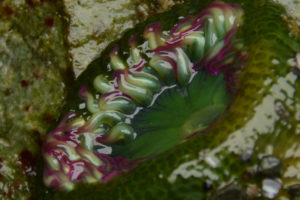
Sea anemone, sea alien, Deception Pass, Washington
“My pictures have seen the world; printed in National Geographic, they get around. Dentist offices everywhere, barbershops in Bhutan. You know.
But for all their connections with the real world, photographs too often lead disconnected lives. It is as if, after their moment of creation, they go off to live in a foreign country. They talk to the wider world, spread instantly across the planet, but with the folks back home, where they were born, not so much. Sometimes they act like children estranged from their parents, all links severed with the real world where they were born.”
Jim Richardson in A Long Love Affair With the Scottish Isles, in Pictures
This is not my hope. Rather, as Jim Richardson goes on to say in his essay, I want my photos to have a life. Too often people live in a place that they don’t really see or they visit a landscape that is unfamiliar and see only what they came to see – the interstate, a specific trail, or paddle route. I want my photographs to convey the intrinsic value of these landscapes and the beauty that may not be readily apparent. I want the connections between people and wild places to be always fresh and strong with the hope that more every day life decisions are informed by the need for wilderness. No estranged children here, please.
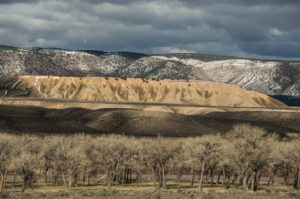
Cottonwoods dwarfed by the landscape
See Jim Richardson’s essay here: http://proof.nationalgeographic.com/2016/04/05/a-long-love-affair-with-the-scottish-isles-in-pictures/?utm_source=NatGeocom&utm_medium=Email&utm_content=pom_20160410&utm_campaign=Content&utm_rd=15302027
We put thirty spokes together and call it a wheel;
But it is on the space where there is nothing that the usefulness of the wheel depends.
We turn clay to make a vessel;
But it is on the space where there is nothing that the usefulness of the vessel depends.
We pierce doors and windows to make a house;
And it is on these spaces where there is nothing that the usefulness of the house depends.
Therefore just as we take advantage of what is, we should recognize the usefulness of what is not. Dao de jing
29 July 2000, Cooper Island, Alaska
I’ve been walking since I got up this morning, and eating, of course. The wind and rain of the other day finally passed. Yesterday was foggy and freezing; everything was covered with a thin sheet of ice. The fog lifted briefly in the afternoon and it was warm. This morning when I awoke the air was absolutely dead calm, the fog as thick as it has ever been. And so, I walked.
There is silence and stillness to this fog world that is unmatched. Even intensely cold days in the north woods have sound and a feeling of motion: the creak of ice laden branches as they sway under their burdens, the crunch of sub-zero-temperature snow underfoot. This Arctic fog stillness is absolute.
To stand on the edge of the water and look into the gray void created by the sky and water uniting in color and texture is to truly experience sensory deprivation. Except for a few birds, my footsteps, and the almost imperceptible wash of water on the shore there is no sound, even these few things you must work to hear. All sense of sight is gone; the utterly calm water perfectly mirrors the sky, eliminating any evidence of a boundary between them. Without an automatic brain override of the fog, I would think I was losing my sight.
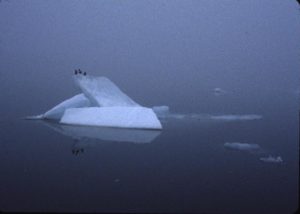
Black guillemots on ice floe
Now and then, on the lagoon side of the island, a dark spot that is a loon or a long-tailed duck will break free of the fog and show itself, giving definitive life to the water and proving that there is more than one dimension. On the ocean side, ice floes loom, moving imperceptibly; they often calve. The sound, that distorted fog sound, travels across the water. In the ocean there is no change, no motion, and no acknowledgement by the water or the air that the ice balance has shifted. Only silence once again.
Occasionally a red-throated loon gives its eerie, raspy, almost desperate call. No loon is in sight but I know it is among the ice floes, bill pointed to the foggy sky, head cocked to one side, listening into the silence for an answer. Listening for any sound at all, some proof that the rest of the world still exists. Is it only in our imagination that there was once wind and motion, sounds of water washing against the shore, or the persistent calls of numerous other birds?
I attempted many photos of this deprivation, some hard fast object in the foreground with the limitless depths of fog-gray-void behind. How does one record the lack of something to see? I’m not sure. If there is anything in these photos, any depth or contrast, any color, any motion, they will be stupendous indeed. In many ways this is the essence of my purpose here, to record that which is not plainly visible, to show that despite this seeming void, life thrives just out of view, and that there is usefulness in that which we cannot see and do not know.
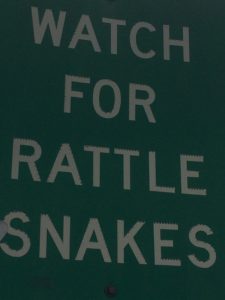
Watch for rattlesnakes
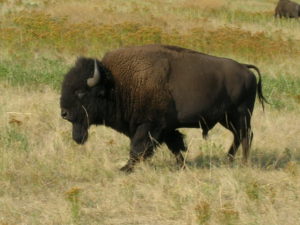
Part 1. People are stupid
Recently I saw a video of a woman and a bison. The bison was lying next to a walkway in Yellowstone National Park. The woman stopped to pet it on the head as casually as if she was petting a favorite horse. As if brushing off a fly, the bison tossed its head at her. She stepped back and made a face, as if scolding it, then reached out and touched it again. Again the bison tossed its head. Amazingly, the woman walked away without being gored, trampled, or obliterated by the 1000-pound wild bison.
Part 2. People are stupid
Driving down a narrow canyon somewhere I can’t now remember in Colorado I came upon a bighorn ram with a beautiful full curl. It was late November, the end of the rut. The ram was standing on the double yellow line, broadside to traffic, with no apparent interest in anything but the slope in front of him. At the time, I still had my Tercel, a car seemingly half the size of the ram. I had never seen a bighorn sheep before; I shut off the engine and watched.
After several minutes, a brand-new, bright red, dual rear-wheel, Dodge Ram 2500 diesel came up the canyon. The ram did not move. The truck sat a minute and then slowly rolled forward. The ram held his ground. The truck moved another few feet forward.
The ram politely stepped back one step, and then one more. The truck began to inch ahead. The ram took another step back, lowered his head, and let loose with all of the power of the rut directly into the front quarter panel of the shiny truck.
I laughed, of course. The expression of the man driving the truck was beyond description.
The ram, head held high, stepped back; clearly, he won this round. Another step back. The truck driver writhed in his seat, livid. It seemed his instinct was to immediately get out to check damage. Instead, he decided to move ahead. Was it an attempt to flee to safety? The ram stepped back again, lowered his head, and connected with a new spot on the front quarter panel.
Concealed weapons permits were not big then and I wasn’t yet fully aware of how many people carried weapons in their rigs. I writhed in my seat, in mirth. What more could a girl new to the west ask for than a show like this?
I don’t remember what broke the stand off. The ram finally turned into the canyon below the road and the truck continued up the canyon.
Part 3. Sadly, I count as people
A few years later I was working on the National Bison Range in Montana. I spent my days hiking everywhere, mapping plant communities, taking photos, enjoying the wildlife.
Early one morning, while the world was still cool and snakes were not warmed up, I found a den. I was standing on a slope deciding whether to go up or down. I turned up, picked up my foot, heard a rattle and just continued spinning back down to the point where I began. I turned to look. Two large snakes, two to three feet long, were coiled side by side. Next to them was a ball of snake babies. The babies were a wriggling mass. As I watched, one of the larger snakes disappeared into a hole under a rock. The babies, one by one, extracted themselves from the ball and followed – nine in all, each about 10 inches long. As the last baby went into the hole, the second larger snake followed.
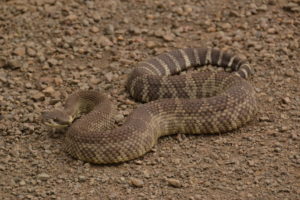
Rattlesnakes are fascinating and fabulous. They are also much maligned and persecuted creatures. People go out of their way to run them over, shoot them, burn them out, and kill them with any handy tool, shovel, or ax.
A rancher, well into his 60s, once told me that he had been killing them since he was a kid. “I used to see a hundred or more a year. Now, I don’t see more than ten a year.”
“That’s because you killed them all,” I responded.
“Well, yeah, I guess so. I hadn’t thought about that.”
Really. He said that.
Back to the Bison Range. One day, after a long, hot day of hiking around on the range, I was driving the loop road on my way to the maintenance shop. Climbing onto the flat above the river, there was a rattlesnake in the middle of the road. It was about 3 and a half feet long, basking in the sun, unperturbed by my truck. I went around it.
Then, I stopped. I looked back. Some stupid tourist will either run over it or will try to get too close and get bitten. Damn.
There were half a dozen elk antlers in the back of the truck. I collected them as I hiked and added them to the visitor center pile every few weeks (…or took them home. One of those two things, I can’t remember which). I fished out the longest one and walked back to the snake.
I told the snake it was a bad idea to lie in the middle of the road and maybe it should move to the side. It shifted back, not coiling, but changing from a long line of snake into a wavy line of attentiveness. I reached out with the antler and gently prodded it. The snake moved away, closer to the edge of the road; I prodded it again. It moved off the road a foot or two.
Just a little further, I said. You’re too likely to go back to the road when I quit poking at you. Another prod, another few feet.
One more time, just a few more feet, I thought. By now, the snake was moving backward but was also in a full coil. Yes, of course, I know what this means. I reached as far as I could with the antler, using my natural length to keep as much distance between us as possible and I gave it one.more.poke.
It struck; I leaped. We both turned and went our own ways. We both stopped and looked back.
They say the striking distance of a rattlesnake is more or less equivalent to its length. The snake was three and a half-ish feet long. My arm is three feet, the antler was three feet, I’m six feet… the math may or may not have worked in my favor but I went with it.
I remember throwing the antler into the back of the truck and saying out loud, “Headline at 11:00, biologist struck by rattlesnake while saving stupid tourists.”
I can imagine the snake going back to its snake buddies and telling them, “you would not believe what happened to me today.” I know I did. And, we both lived to tell the tale: people are stupid.
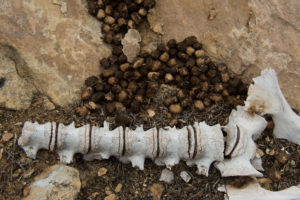
In the last four days, I found five fresh elk carcasses, three skeletons, and two big piles of cat scat. Where are the big cats? As I walk through this landscape of stone and pine I wonder if they are lounging on a ledge somewhere watching me. Are they snickering into their paws as I look more compulsively over my shoulder?
I have a big jar of catnip. Will that gain me an audience?
A month ago, the thought that I would be delighted to be in Nebraska would have made me laugh.
Traveling west through Missouri to Kansas City leaves few options for continuing west: I could cross Kansas or Nebraska. I’ve driven through both states before but it requires some fortitude, perseverance, and a lot of will power; there is a reason they are called fly over states.
This time, I decided to go through Nebraska hoping the Sandhill crane migration on the Platte River would break up the trip. Alas, I missed the migration and still had three-quarters of the state to cross.
Having missed the cranes, I decided to stop at Crescent Lake National Wildlife Refuge in the Sandhills. I had no idea whether there would be cranes or not but a few days of spring migration bird watching on a wildlife refuge sounded lovely.
I often take crazy, circuitous routes from point A to point B. Sometimes this is on purpose; sometimes I just stink at navigating. In states like Nebraska, I feel confident that what I see from the interstate is what I would also see from any other road in the state.
I turned off the interstate at Ogallala and worked my way northwest to Oshkosh. From there I drove 28 miles of terrible road. I’ve driven a lot of back roads all over the country; this road gets special mention. First, it’s sand. Then, it’s washboard. I’m not sure how sand turns to washboard but there it is. Trying not to lose my teeth on the washboards, a sand pit would appear; using enough power to prevent bogging down in the sand, meant I would then rocket back onto washboard.
Eventually, the road turns back to pavement – the original pavement from the inception of the refuge in 1931. The pavement is almost as bad; barely a lane wide with washboards, potholes, and patches. Again, not sure how pavement turns to washboard but… Despite the road condition, the refuge felt compelled to set a speed limit: a hopeful 35 miles per hour. Not known for my grandmotherly driving, I maxed out at about 22. Luckily, there was no other traffic so I was able to use any section of the road that suited me and avoided the previously mentioned pitfalls.
Without quite realizing it, somewhere along the drive north into the Sandhills, I lost the cornfields. The seemingly endless flat turned to rolling hills and grasslands. A few creeks ran through the scene and as I moved north more lakes appeared.
I stopped at the refuge boundary and popped up for the night at a state fishing access on Blue Lake. As I walked up the road from the lake, a fluttery brown motion caught my eye; a burrowing owl landed on a mound of fresh soil.
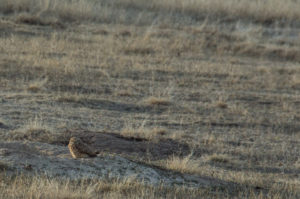
Burrowing owl on prairie dog mound
In my opinion, burrowing owls are the meerkats of North America. They nest in prairie dog burrows and have a habit of stretching tall and standing upright like meerkats. Plus, they are similarly ridiculously cute. Unlike many owls, they are diurnal and are readily visible during the day. The evening was full of their coo-coooooo calls. I counted three the first evening but eventually found at least seven owls in that prairie dog town.
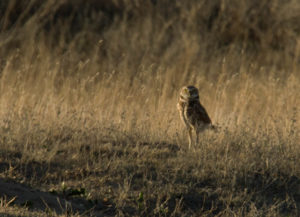
Burrowing owl doing its meerkat impersonation.
Mountain time zone begins somewhere in mid-Nebraska, being on the eastern edge of the time zone meant an early sunrise. The western meadowlarks began singing long before there was light in the eastern sky. They were everywhere and incessant in their calls. It’s spring, after all, and there are territories to be defended and mates to attract.
Next to the lake, the red-winged blackbirds were bouncing around trilling and fighting. The cattails and marsh grasses haven’t grown enough yet this season for them to hang out there. Instead, two- or three-dozen birds clumped up in two scrawny little willow shrubs right next to the lake, and right next to the camper.
Through the day on the refuge, I found long-billed curlews and white-faced ibis and heard American bitterns, Unk-a-chunk, Unk-a-chunk. Northern harriers and turkey vultures worked the landscape while northern shovelers, blue-winged teal, and scaup plied the waters. Killdeer filled the air with their Ki-dee, ki-dee, ki-dee all day long. I flushed several sharp-tailed grouse and searched out greater prairie chickens on their lek.
The birds aside, I spent the day reveling in the endless sky and the open horizon. Hills rolling one into the next for as far as I could see, broken only by small lakes here and there. As the evening came, I watched several massive storm cells build to the east. I could see virga (rain that falls from clouds but evaporates before it hits the ground) falling in waves as the setting sun made everything glow in colors that only seem to appear in western skies. I was delighted to be in Nebraska and, beyond that, I was delighted to be back in the west.